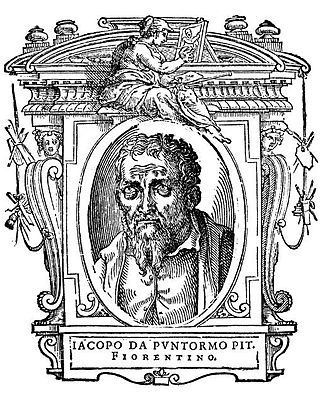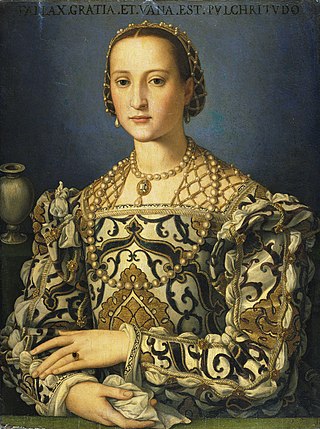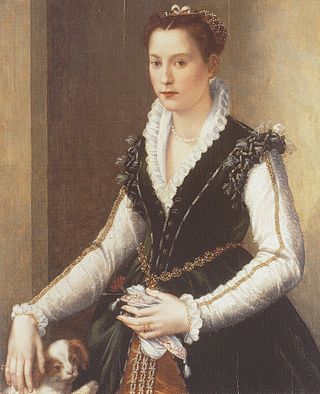
Alessandro di Cristofano di Lorenzo del Bronzino Allori was an Italian painter of the late Mannerist Florentine school.

Mannerism is a style in European art that emerged in the later years of the Italian High Renaissance around 1520, spreading by about 1530 and lasting until about the end of the 16th century in Italy, when the Baroque style largely replaced it. Northern Mannerism continued into the early 17th century.

Cosimo I de' Medici was the second Duke of Florence from 1537 until 1569, when he became the first Grand Duke of Tuscany, a title he held until his death.

Jacopo Carucci, usually known as Jacopo da Pontormo, Jacopo Pontormo, or simply Pontormo, was an Italian Mannerist painter and portraitist from the Florentine School. His work represents a profound stylistic shift from the calm perspectival regularity that characterized the art of the Florentine Renaissance. He is famous for his use of twining poses, coupled with ambiguous perspective; his figures often seem to float in an uncertain environment, unhampered by the forces of gravity.

The Palazzo Vecchio is the town hall of Florence, Italy. It overlooks the Piazza della Signoria, which holds a copy of Michelangelo's David statue, and the gallery of statues in the adjacent Loggia dei Lanzi.

The Palazzo Pitti, in English sometimes called the Pitti Palace, is a vast, mainly Renaissance, palace in Florence, Italy. It is situated on the south side of the River Arno, a short distance from the Ponte Vecchio. The core of the present palazzo dates from 1458 and was originally the town residence of Luca Pitti, an ambitious Florentine banker.

Agnolo di Cosimo, usually known as Bronzino or Agnolo Bronzino, was an Italian Mannerist painter from Florence. His sobriquet, Bronzino, may refer to his relatively dark skin or reddish hair.

Eleanor of Toledo, born Doña Leonor Álvarez de Toledo y Osorio, was a Spanish noblewoman and Duchess of Florence as the first wife of Cosimo I de' Medici. A keen businesswoman, she financed many of her husband's political campaigns and important buildings like the Pitti Palace. She ruled as regent of Florence during his frequent absences: Eleanor ruled during Cosimo's military campaigns in Genoa in 1541 and 1543, his illness from 1544 to 1545, and again at times when the war for the conquest of Siena (1551–1554). She founded many Jesuit churches. She is credited with being the first modern first lady or consort.

Francesco Salviati or Francesco de' Rossi was an Italian Mannerist painter who lived and worked in Florence, with periods in Bologna and Venice, ending with a long period in Rome, where he died. He is known by various names, usually the adopted one of Francesco Salviati or Il Salviati, after an early patron, but also Francesco Rossi and Cecchino del Salviati.

Francesco d'Ubertino Verdi, called Bachiacca. He is also known as Francesco Ubertini, il Bacchiacca (1494–1557). He was an Italian painter of the Renaissance whose work is characteristic of the Florentine Mannerist style.

Isabella Romola de' Medici was the daughter of Cosimo I de' Medici, first Grand Duke of Tuscany, and Eleonora di Toledo. She was raised and educated in a humanist manner with her siblings, including Francesco de' Medici who succeeded their father as the Grand Duke of Tuscany. To secure a relationship with the powerful Roman Orsinis, Isabella's father arranged her marriage to Paolo Giordano I Orsini when she was 16. She remained in her father's household after her marriage, giving her an unusual degree of independence for a woman of her period. Following the death of her father, Isabella was probably murdered, with the complicity of her husband and brother, and in retribution for her relationship with Paolo Giordano's cousin Troilo Orsini.

The Portrait of Eleanor of Toledo and Her Son is a painting by the Italian artist Agnolo di Cosimo, known as Bronzino, finished ca. 1545. One of his most famous works, it is housed in the Uffizi Gallery of Florence, Italy and is considered one of the preeminent examples of Mannerist portraiture. The painting depicts Eleanor of Toledo, the wife of Cosimo I de' Medici, Grand Duke of Tuscany, sitting with her hand resting on the shoulder of one of her sons. This gesture, as well as the pomegranate motif on her dress, referred to her role as mother. Eleanor wears a heavily brocaded dress with black arabesques. In this pose, she is depicted as the ideal woman of the Renaissance. The painting is the first known state-commissioned portrait to include the ruler's heir. By including the child, Cosimo wished to imply that his rule would bring stability to the duchy.

The Deposition of Christ is a painting by the Italian artist Agnolo di Cosimo, known as Bronzino, completed in 1545. It is housed in the Musée des Beaux-Arts de Besançon, France. A copy by Bronzino can be found in the Palazzo Vecchio. This portrayal of the Deposition, although it depicts all the characters typically shown when Jesus is being taken down from the cross, more correctly should be characterized as a Lamentation and is an excellent example of late Mannerism or Maniera.

The Crossing of the Red Sea, also known as The Crossing of the Red Sea and Moses Appointing Joshua, is a fresco painting by the Italian artist Agnolo di Cosimo, known as Bronzino, finished in 1542. It depicts the Nation of Israel crossing the Red Sea from the book of Exodus and Moses commissioning Joshua to lead the Israelites into the promised land from the book of Numbers. It is housed in the Palazzo Vecchio, Florence.
Events from the year 1545 in art.

Maria Salviati was a Florentine noblewoman, the daughter of Lucrezia di Lorenzo de' Medici and Jacopo Salviati. She married Giovanni delle Bande Nere and was the mother of Cosimo I de Medici. Her husband died 30 November 1526, leaving her a widow at the age of 27. Salviati never remarried; after her husband's death she adopted the somber garb of a novice, which is how she is remembered today as numerous late portraits show her attired in black and white.

Eleonora di Garzia di Toledo or Leonor Álvarez de Toledo Osorio, more often known as "Leonora" or "Dianora", was the daughter of García Álvarez de Toledo, 4th Marquis of Villafranca, Duke of Fernandina. Leonora was born in Florence, where she was brought up by Cosimo I de' Medici, Grand Duke of Tuscany and his wife Eleanor of Toledo, her aunt and namesake. Betrothed to their son Pietro at the age of 15, she blossomed under the wing of Pietro's older sister, the artistic patron Isabella, into a vivacious and witty beauty. Her marriage, like Isabella's, was not a success, and she followed her mentor's example of taking lovers. For this reason, Pietro had her brought in 1576 to the country retreat of Cafaggiolo, where he strangled her to death with a dog leash. Cosimo's successor, Francesco I, tacitly approved the murder, and Pietro was never brought to justice for it.

On 1 or 2 August 1537, near the Tuscan village of Montemurlo, the forces of the newly installed Duke Cosimo I of Florence defeated a hastily organized army of those who wished to overthrow the Medici and restore the Republic of Florence. Following the battle, Cosimo's bloody vengeance on all those who opposed Medici rule effectively ended organized opposition to his family in Florence. The victory led to the decision of Emperor Charles V to formally recognize Cosimo as Duke of Florence on 30 September 1537.

The Portrait of Bia de' Medici is an oil-tempera on wood painting by Agnolo Bronzino, dating to around 1542 and now in the Uffizi in Florence. For a long time it was displayed in the Tribuna at the heart of the museum, but since 2012 it has been moved to the "sale rosse" of the Nuovi Uffizi. A second portrait, by Pontormo, has also been argued to show Bia de' Medici, but this identification is disputed.
Marjorie Elizabeth Cropper is a British-born art historian with a special interest in Italian and French Renaissance and Baroque art and art literature. Dean of the National Gallery of Art’s Center for Advanced Study in the Visual Arts (CASVA) since December 2000, she previously held positions as Professor of Art History at Johns Hopkins University and director of the university’s Charles S. Singleton Center for Italian Studies at Villa Spelman in Florence.




















